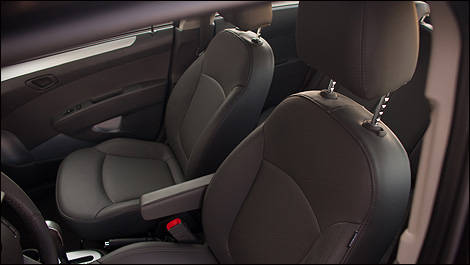In mainstream cars and trucks, more and more manufacturers are offering leather seating surfaces, or leather upholstery.
In the vast majority of cases, it is not real leather, but what is called leatherette or simulated leather. You also have vinyl. What’s the difference?
Genuine leather, obviously, is made from cowhide. Its porous texture allows it to breathe and adjusts to body temperature. It gets softer over time, and in luxury cars, the smell of leather is an important factor. On the other hand, it wears more quickly than leatherette or vinyl, it costs more to produce and if it’s not treated with a protective finish, it will stain and absorb odours more quickly.
Leatherette, or simulated leather, is a synthetic texture made with vinyl, but with a softer feel to match leather as closely as possible. It’s cheaper to produce than leather and easier to keep clean, and more durable. However, it’s generally colder in winter and hotter in summer than the real stuff.
Luxury brands will say that owners and environmentalists want them to offer an alternative to genuine leather so they wouldn’t slay as many cattle -- as if cows were sent to the slaughterhouse only to dress up car cockpits.
Vinyl is the ultimate low-cost texture for seating surfaces. It wears down much less quickly than leather and is the easiest texture to keep clean. However, it stays hard, has a tendency to crack and doesn’t breathe, so on hot days we get all sweaty on them.
While vinyl seating surfaces have become pretty obsolete in passenger cars, some manufacturers will use vinyl on the lower portion or backsides of their leather seats to keep costs down. In most cases it’s not readily apparent, in others it’s obvious.
The problem is that a lot of manufacturers call their seat upholstery leather when it’s in fact leatherette. It couldn’t be more obvious in certain vehicles, including the 2013 Chevrolet Spark I’m currently driving, which has polka dot motifs on the optional “leather” seats.
Frankly, when I analyze the pros and cons, the best compromise in mainstream vehicles is actually leatherette for its combination of durability, appearance and comfort. So why are manufacturers ashamed of calling it “simulated” leather? They shouldn’t be.
In the vast majority of cases, it is not real leather, but what is called leatherette or simulated leather. You also have vinyl. What’s the difference?
Genuine leather, obviously, is made from cowhide. Its porous texture allows it to breathe and adjusts to body temperature. It gets softer over time, and in luxury cars, the smell of leather is an important factor. On the other hand, it wears more quickly than leatherette or vinyl, it costs more to produce and if it’s not treated with a protective finish, it will stain and absorb odours more quickly.
Leatherette, or simulated leather, is a synthetic texture made with vinyl, but with a softer feel to match leather as closely as possible. It’s cheaper to produce than leather and easier to keep clean, and more durable. However, it’s generally colder in winter and hotter in summer than the real stuff.
Luxury brands will say that owners and environmentalists want them to offer an alternative to genuine leather so they wouldn’t slay as many cattle -- as if cows were sent to the slaughterhouse only to dress up car cockpits.
Vinyl is the ultimate low-cost texture for seating surfaces. It wears down much less quickly than leather and is the easiest texture to keep clean. However, it stays hard, has a tendency to crack and doesn’t breathe, so on hot days we get all sweaty on them.
While vinyl seating surfaces have become pretty obsolete in passenger cars, some manufacturers will use vinyl on the lower portion or backsides of their leather seats to keep costs down. In most cases it’s not readily apparent, in others it’s obvious.
 |
| Leatherette, or simulated leather, is a synthetic texture made with vinyl, but with a softer feel to match leather as closely as possible. (Photo: Sébastien D'Amour) |
The problem is that a lot of manufacturers call their seat upholstery leather when it’s in fact leatherette. It couldn’t be more obvious in certain vehicles, including the 2013 Chevrolet Spark I’m currently driving, which has polka dot motifs on the optional “leather” seats.
Frankly, when I analyze the pros and cons, the best compromise in mainstream vehicles is actually leatherette for its combination of durability, appearance and comfort. So why are manufacturers ashamed of calling it “simulated” leather? They shouldn’t be.


